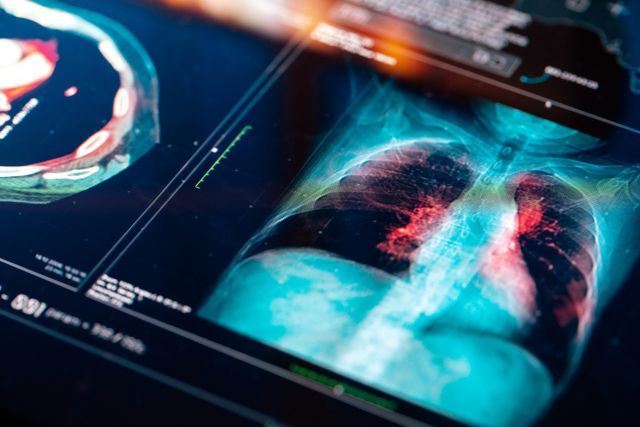Updated on April 4, 2025
Lung cancer is one of the most common cancers in the world, and it’s the leading cause of cancer deaths in the United States for both males and females.
What is lung cancer?
In the simplest terms, cancer is the uncontrolled growth and spread of abnormal or damaged cells. Cancers are named based on where this uncontrolled growth begins inside the body. Lung cancer is cancer that begins in the tissues of the lungs.
Lung cancer falls into two broad categories—small cell lung cancer and non-small cell lung cancer:
- Between 80 to 85 percent of all lung cancers are non-small cell lung cancer (NSCLC). The three most common subtypes of NSCLC are adenocarcinoma, squamous cell carcinoma, and large cell carcinoma.
- Between 10 and 15 percent of lung cancers are small cell lung cancer (SCLC). There are two main types—small cell carcinoma (also called oat cell cancer) and combined small cell carcinoma. SCLCs tend to grow quickly and metastasize aggressively, forming large tumors that spread to other areas of the body.
These two categories of lung cancer are named for the appearance of the cancer cells when viewed with a microscope—NSCLC cells appear larger, and SCLC cells appear smaller. Beyond appearance, there are many important differences between NSCLC and SCLC. There are also many important differences between the subtypes within each category.
There are other lung cancers that are less common—such as lung carcinoid tumors and mesothelioma—as well as cancers that begin in other areas of the body but spread to the lungs.
Lung cancer by the numbers
In the U.S., more than 220,000 people are diagnosed with lung cancer each year. Lung cancer is less common than skin cancer, female breast cancer, and prostate cancer, but it accounts for more cancer deaths. Here are some additional numbers that further illustrate the impact of lung cancer:
- 1 in 5. Cancer deaths that are attributable to lung cancer.
- 120,000, at least. Estimated number of lung cancer deaths in the U.S. each year. This number has been decreasing year over year.
- 70 years. The average age of a person diagnosed with lung cancer. A person’s risk of having lung cancer increases with age, with most cases diagnosed in people over the age of 65. Lung cancer is rare among people under the age of 45, but it does happen.
- 80 to 90 percent. Percentage of lung cancer deaths that are attributable to cigarette smoking. Smoking is the number one risk factor for lung cancer. This includes cigarettes, as well as cigars, pipes, and secondhand smoke. Tobacco use also increases the risk of many other types of cancer and many other diseases.
- 7,000. Number of chemicals in a burning cigarette. At least 69 are known carcinogens, substances that cause cancer.
Should you get screened for lung cancer?
Early detection of lung cancer can lead to better treatment outcomes. Lung cancer is screened with an imaging test called a low-dose computed tomography scan, or CT scan.
According to the U.S. Preventive Services Task Force (USPSTF), a person should be screened for lung cancer:
- If they are between the ages of 50 and 80 years.
- If they currently smoke or have smoked in the past 15 years.
- If they have a 20-year “pack history,” meaning they have averaged the equivalent of one pack of cigarettes per day for 20 years.
If you have questions about your risk of lung cancer or the health of your lungs, your best source of information will be a healthcare provider.






